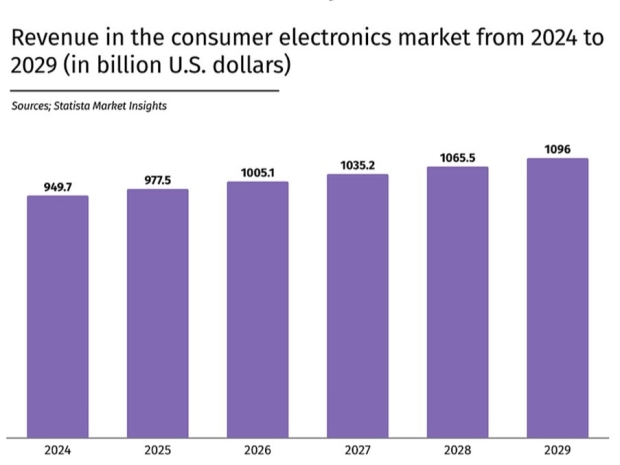The consumer electronics market has faced significant challenges in recent years, with global sales fluctuating as consumers adjusted their budgets and spending priorities in response to rising costs and inflation.
This downturn has led to a substantial $10 billion revenue decline since the market’s peak in 2021. But despite these setbacks, the industry is on the verge of a significant achievement.
Consumers worldwide are spending much less on electronic devices these days. Rising costs, inflation, and shifting consumer priorities have driven a substantial decline, including a $42 billion drop in 2022 and an expected $6 billion dip by the end of 2024. Still, the market shows resilience, setting the stage for steady growth in the coming years.
Neil Roary, analyst, Stocklytics, said: “The industry is poised for five years of moderate expansion, helping it to reach a new massive milestone. After hitting a $977.5 billion value next year, consumer electronics are expected to become a trillion-dollar industry in 2026. Moreover, this figure is forecasted to jump by another 10 per cent by the end of a decade, with global electronics sales climbing to nearly $1.1 trillion in 2029.”
Statista expects total sales volume to also increase in this period, rising from 8.2 million units to over 9 million. In contrast, the average price per unit in the consumer electronics segment will jump by six per cent and hit $121.7 by the decade's end.
Although the consumer electronics market’s recovery may be gradual, it signals a promising future for the industry. However, not all market segments will see the same growth. Statista data show that key product segments like smartphones, gaming equipment, and TV peripheral devices will be pivotal in the expected recovery.
Global smartphone sales will grow eight per cent, reaching $521 billion by 2026 and nearly $580 billion by 2029. Statistics show the gaming equipment sales will increase by 12 per cent and hit $38.3 billion.
That is only one-third of the growth rate expected in the streaming devices segment.
According to Statista, consumers worldwide will spend almost $17 billion on streaming devices, like smart TV boxes, streaming sticks, and video players by 2029, 40 per cent more than this year, showing the biggest growth among all market segments.
In contrast, computing, drones, TV, radio, and multimedia will see much lower growth rates, with their revenues rising by 12 per cent, 11 per cent, and 9 per cent in this period, respectively.




